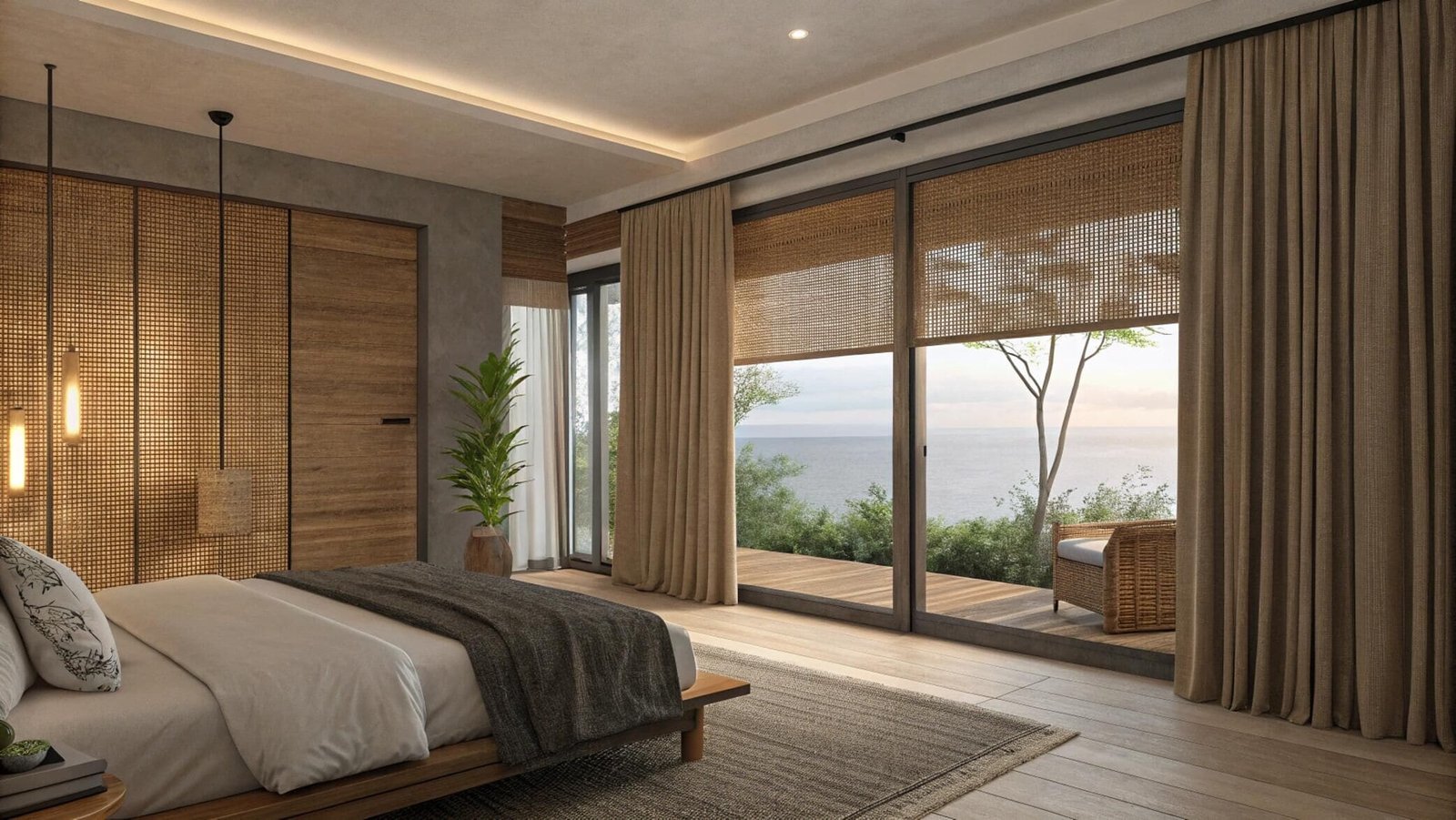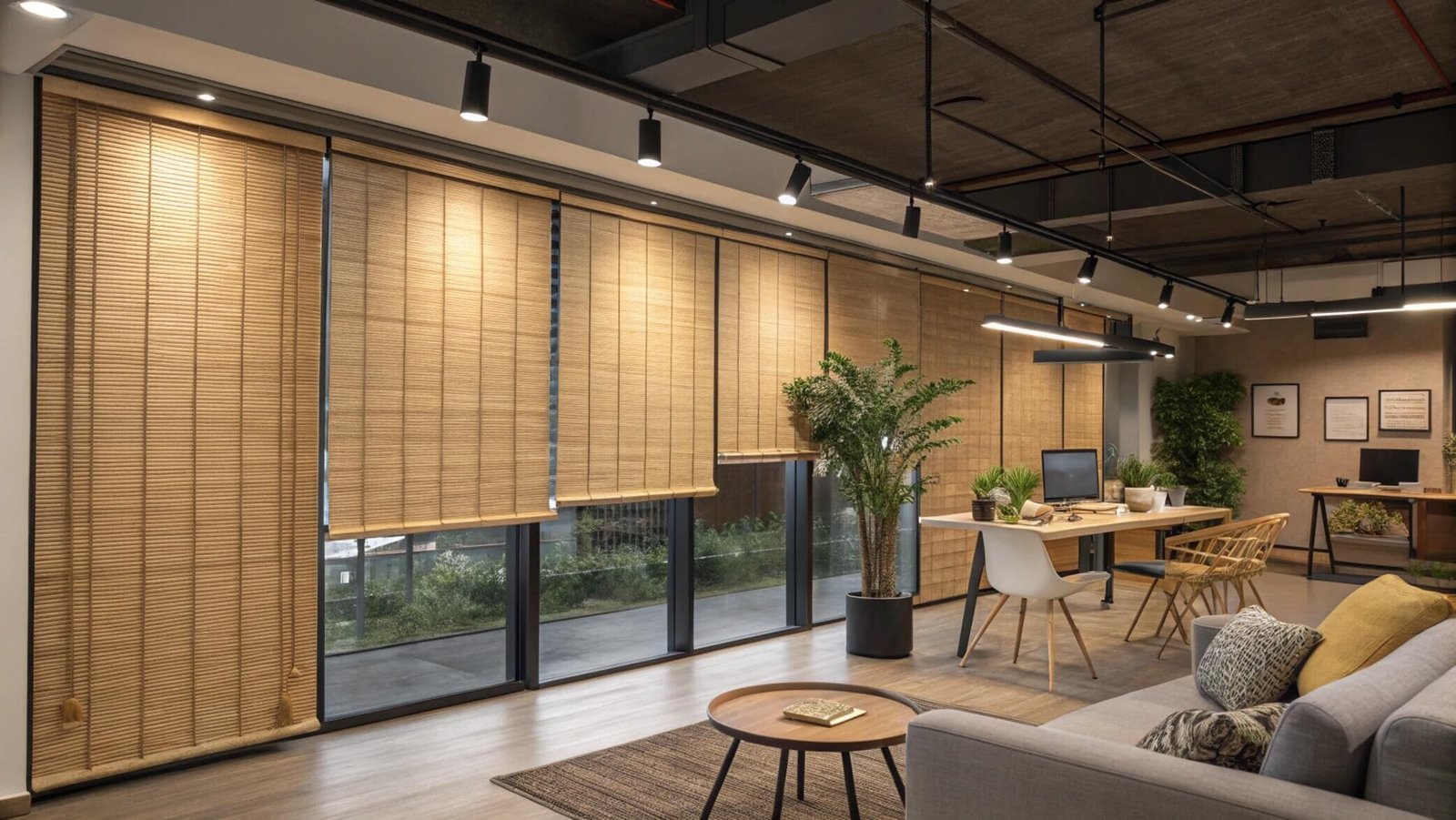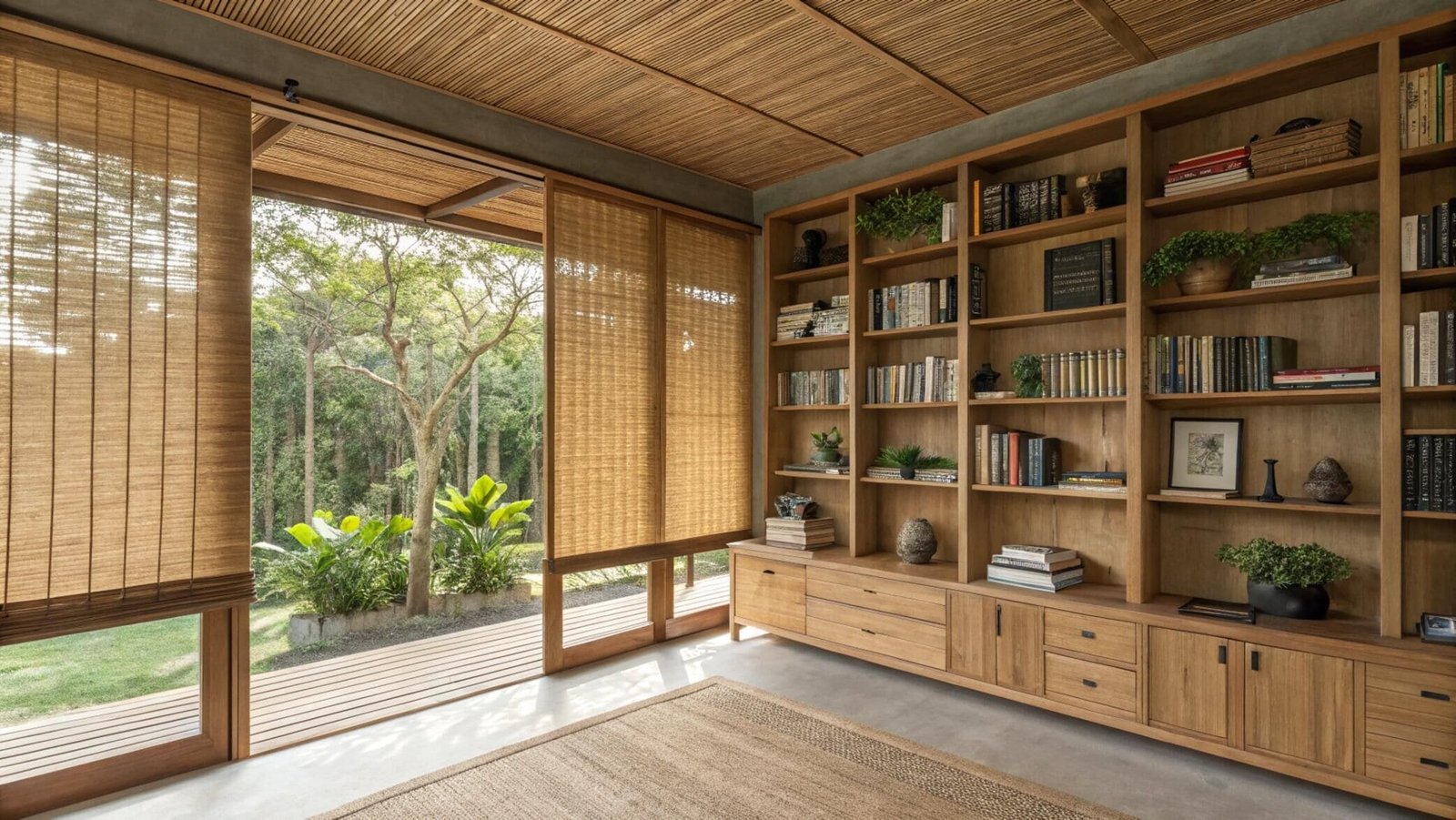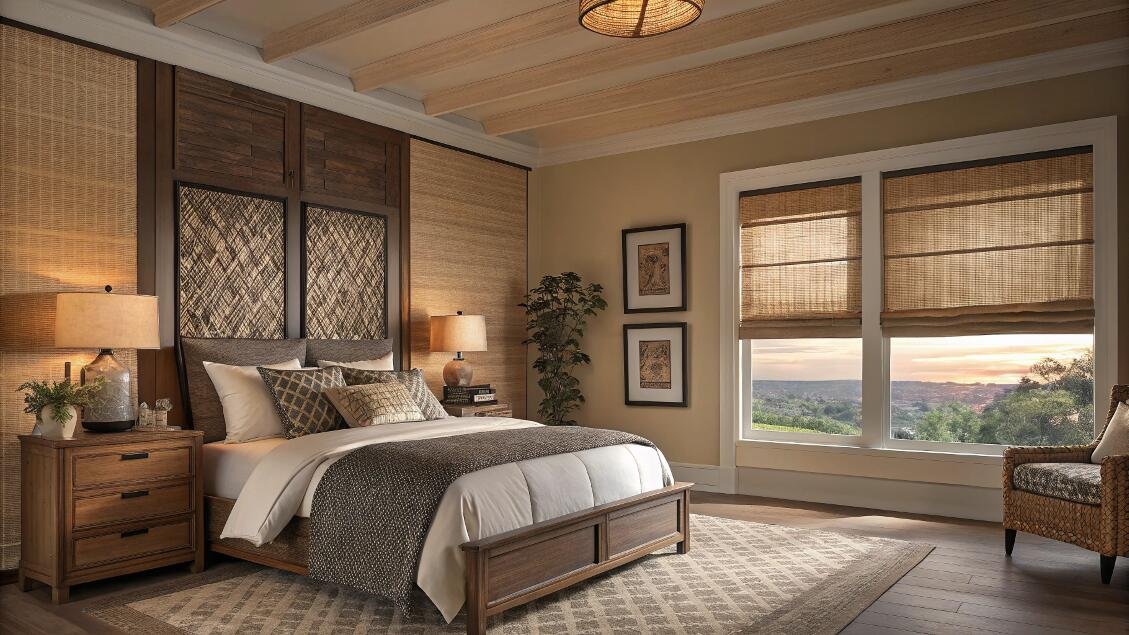You love the warm, natural texture of bamboo shades[^1] for a project, but the room requires total darkness. The client wants the organic style of bamboo for their bedroom, but you know a standard woven shade will let light seep in, disrupting sleep and compromising privacy.
Bamboo shades are naturally light-filtering and do not block light on their own. To achieve a blackout effect, you must add a blackout liner to the back of the shade or layer it with blackout curtains. This approach combines the aesthetic you want with the function you need.

I guide clients through this decision all the time. The key is to stop thinking of it as an "either/or" choice between style and function. The smartest approach is to layer these beautiful, natural texture[^2]s with modern, high-performance liners. This way, you don’t have to sacrifice the organic look to solve the practical problems of light control and privacy. Let's break down how to get it right.
Do Bamboo Shades Block Light?
You see a product labeled "bamboo shade" and might assume it provides solid coverage. However, once installed, you're surprised by the amount of light bleeding through the natural weave.
Standard bamboo shades do not block light; they filter it. The natural, woven construction[^3] is designed to soften sunlight and create a warm, inviting glow, not to provide room darkening or complete privacy.

The term "shade" can be misleading here. Unlike a solid roller shade, a bamboo shade is crafted from weaving together individual slats of natural bamboo, reeds, and grasses. By its very nature, this process leaves tiny gaps and openings. These gaps are what create the beautiful, diffused light that defines the style. Think of it like a solar shade with a very high openness factor. While perfect for living rooms or studies where you want to reduce glare while maintaining a bright, airy feel, it's not a blackout solution on its own.
How Do I Make My Bamboo Blinds Blackout?
Your client is set on the bamboo look for a bedroom, but the light filtering[^4] is a dealbreaker. You don't want to abandon the design vision, but you need a truly dark room.
To make bamboo blinds blackout, the most effective methods are adding a blackout liner directly to the shade or layering them with a separate blackout window treatment, such as curtains or a dual roller shade system.

You don't have to start over; you just need to augment the shade. Here are the professional solutions:
- Add a Blackout Liner: This is the most common and integrated approach. A layer of opaque fabric is attached directly to the back of the bamboo shade. When lowered, it looks like a single, cohesive unit that provides excellent light blockage.
- Layer with Blackout Curtains: A classic and versatile design choice. The bamboo shade is mounted inside the window frame to provide texture and daytime light filtering, while a set of thick blackout curtains is mounted on a rod outside the frame for complete darkness when needed.
- Use a Dual Shade System: For ultimate flexibility, you can pair a decorative bamboo shade[^5] with a separate, highly functional blackout roller shade on a single bracket. This allows you to have the textured bamboo look during the day and switch to a full blackout shade at night.
How Can I Make Bamboo Shades More Private?
The client loves the daytime look of their bamboo shades, but they're concerned about feeling exposed after sunset. The standard weave simply doesn't offer enough privacy for a bedroom or a street-facing window.
The best way to make bamboo shades private is to add a privacy liner. For even greater security, installing the shade as an "outside mount" will cover the light gaps[^6] along the window edges where someone might be able to peek in.

Privacy and blackout aren't the same thing, and it's important to specify the right solution.
- Privacy Liners: A privacy liner[^7] is a thin layer of fabric that is opaque enough to block any view through the shade but is not thick enough to block all light. This is a great choice for living spaces where you want to maintain a bright feel without being visible to outsiders.
- Blackout Liners: A blackout liner[^8] does both: it blocks the view completely and stops nearly all light from passing through. This is essential for bedrooms.
- Mounting Technique: The installation method also plays a role in privacy. An inside mount offers a clean, flush look but often leaves small "light gaps" on the sides. An outside mount, where the shade overlaps the window frame, is more effective at covering these gaps and maximizing privacy.
Can You See Through Bamboo Shades at Night?
The shades look perfectly private during the day. But once the sun sets and the interior lights are switched on, the situation can change dramatically, creating an uncomfortable feeling of exposure.
Yes, without a liner, you can easily see through unlined bamboo shades at night. When it's dark outside and your lights are on inside, the woven material does little to obscure the view from the exterior, creating a "fishbowl effect."

This is a critical point I always raise with clients, especially for urban or suburban projects where houses are close together. The privacy you perceive during the day is based on it being brighter outside than inside. At night, that dynamic reverses. The light source is now inside your home, illuminating the interior for anyone looking in. For any room where nighttime privacy is a concern—especially bedrooms and street-level living rooms—a liner is not an optional accessory; it's a mandatory component.
What Blinds Can You Not See Through at Night?
Your project demands guaranteed, 100% nighttime privacy. The client needs to feel secure, and a standard woven shade won't cut it. You need to know the foolproof options.
For absolute nighttime privacy, you must choose a window covering[^9] made from a completely opaque material or one equipped with a blackout liner. The best options are blackout roller shades, cellular shades, lined Roman shades, and dual shade system[^10]s.

These solutions are designed specifically to block both light and views.
- Blackout Roller Shades: Made from a solid sheet of opaque fabric, offering a complete barrier.
- Honeycomb (Cellular) Shades: When made with blackout fabrics, their cell structure provides excellent opacity and insulation.
- Roman Shades with Blackout Liner: These offer the soft, decorative look of fabric with the hard-working function of an integrated blackout layer.
- Dual Roller Systems: This is the premium choice for flexibility, combining a light-filtering or solar shade for day with a full blackout shade for night on one sleek bracket.
These options provide the peace of mind that an unlined bamboo shade simply cannot offer.
Are Bamboo Shades Still in Style?
You want to specify a material that feels current and sophisticated, not a passing fad that will date your project in a few years. You need to know if bamboo has lasting appeal.
Yes, bamboo shades are very much in style and are set to remain popular. Their natural texture and eco-friendly credentials align perfectly with major 2025 interior design trends[^11] like biophilic design[^12] and sustainable living[^13].

Bamboo shades are a cornerstone of the movement toward interiors that feel more connected to nature. Here's why they remain relevant:
- Texture over Flatness: Design is moving away from purely minimalist, flat surfaces and embracing materials with tangible texture. Bamboo's organic weave adds depth and character to a room.
- Sustainability: As clients become more eco-conscious, materials that are renewable and sustainable, like bamboo, are in high demand.
- Warmth and Atmosphere: The way woven shades filter natural light creates a warm, soft ambiance that is a hallmark of cozy and inviting modern design.
They are less of a "trend" and more of a timeless tool for creating warm, textured, and nature-inspired spaces.
What Are the Disadvantages of Bamboo Blinds?
You love the aesthetic of bamboo, but you know that every material has its limitations. To avoid problems down the line, you need to understand the potential downsides before you specify them for a project.
The main disadvantages of bamboo blinds are their lack of built-in privacy and blackout control, their vulnerability to moisture damage[^14], and cleaning challenges[^15] due to their textured surface[^16].

Being upfront with clients about these trade-offs is crucial.
| Disadvantage | The Reality and Why It Matters |
|---|---|
| Light & Privacy Control | The natural weave filters light but doesn't block it. A liner is required for privacy and room darkening, which adds to the cost and complexity. |
| Vulnerability to Moisture | As a natural wood product, bamboo will absorb humidity, causing it to warp, discolor, or grow mold. This makes it completely unsuitable for full bathrooms or damp basements. |
| Cleaning & Maintenance | The uneven, textured surface traps dust and can be difficult to clean. Unlike a smooth blind you can wipe down, bamboo requires careful vacuuming with a brush attachment. |
| Durability | The natural fibers can become brittle over time, especially with sun exposure. Cords can fray, and the delicate woven pattern can sometimes snag or break. |
Conclusion
Bamboo shades offer unbeatable organic texture but require layering to meet modern needs for privacy and light control. The best approach is to pair their natural beauty with a high-performance blackout liner or a dual shade system to get a solution that is both stylish and functional.
---
[^1]: Explore the unique advantages of bamboo shades, including their eco-friendliness and aesthetic appeal.
[^2]: Discover the significance of natural textures in creating inviting and warm spaces.
[^3]: Explore the craftsmanship behind bamboo shades and how it affects light diffusion.
[^4]: Find out how light filtering works and its benefits for creating a warm ambiance.
[^5]: Discover how decorative bamboo shades can elevate your interior design.
[^6]: Find effective strategies to reduce light gaps for better privacy and darkness.
[^7]: Understand how privacy liners can enhance the functionality of bamboo shades for better seclusion.
[^8]: Learn how blackout liners enhance bamboo shades for improved light control and privacy.
[^9]: Learn about window coverings that guarantee privacy and light control.
[^10]: Learn about dual shade systems and how they offer flexibility in light control.
[^11]: Stay updated on the latest trends that influence modern interior design choices.
[^12]: Explore how biophilic design principles enhance the connection between nature and living spaces.
[^13]: Learn about the eco-friendly benefits of using bamboo in home decor.
[^14]: Understand the vulnerabilities of bamboo shades and how to protect them from moisture.
[^15]: Find effective cleaning tips to maintain the beauty of bamboo shades.
[^16]: Discover how textured surfaces add depth and character to interior spaces.Partner with VelaBlinds for Your Next Project
Smart window treatments shouldn't be complicated. After working with 500+ distributors and contractors worldwide, I've streamlined the process to get you quality products, competitive pricing, and reliable support - every time.
Why project professionals choose VelaBlinds:
- ✅ Fast, Accurate Quotes - Detailed specs and pricing within 24 hours
- ✅ Transparent Pricing - No hidden fees, volume discounts clearly outlined
- ✅ Quality Assurance - Direct partnerships with certified OEM manufacturers
- ✅ Project Support - Dedicated account manager from quote to delivery
Start your next project:
📧 Quick Quote: Send your requirements to info@velablinds.com
📱 Direct Contact: WhatsApp +86 137 2012 8317
🌐 Browse Solutions: https://velablinds.com/
📁 Product Resources: Access spec sheets, catalogs & project files
Paul Chen, Founder
"I built VelaBlinds to solve the real challenges I faced as a project buyer - long lead times, unclear specs, and unreliable suppliers. Let's discuss how we can power your projects with smarter blinds."
Serving distributors and contractors across North America, Europe, and Australia since 2018.




